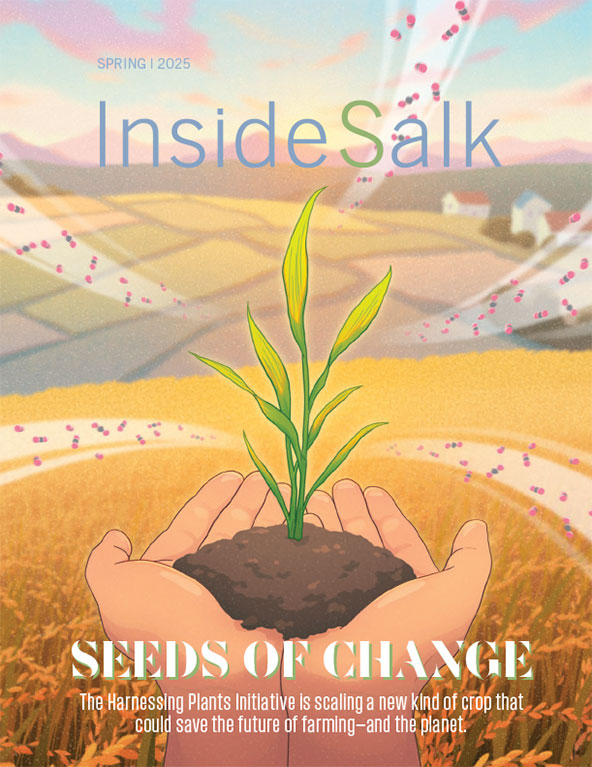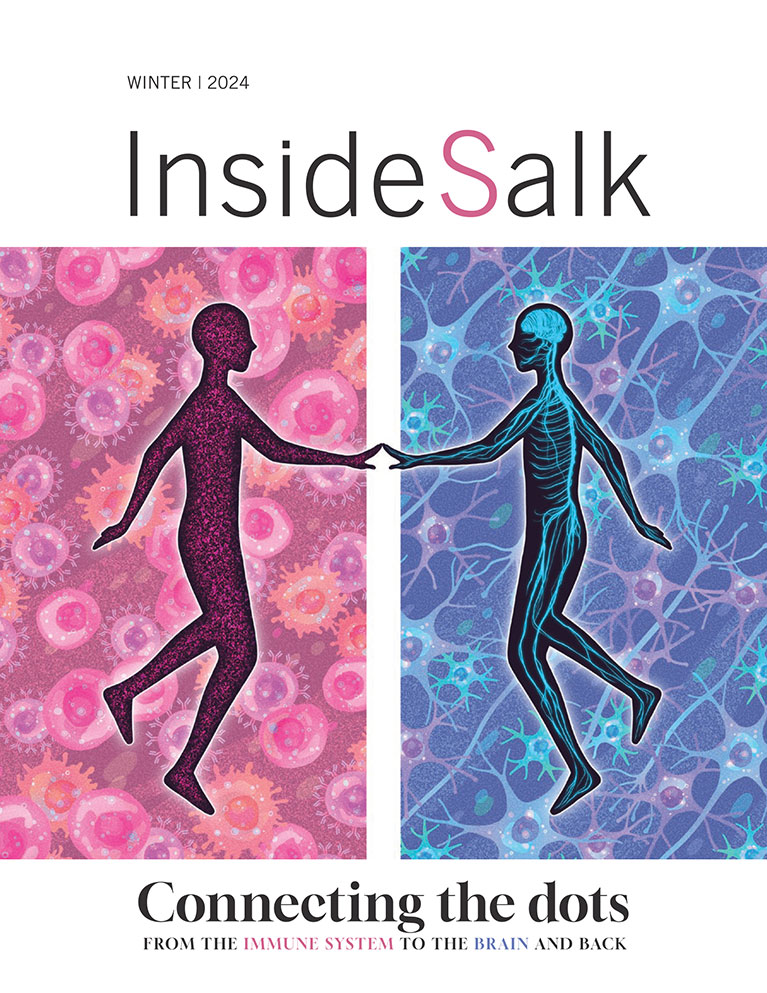Nuttida Rungratsameetaweemana Drawing from memories
Nuttida Rungratsameetaweemana, a Salk postdoctoral researcher who studies neuroscience, was introduced to the perplexities of the brain at age 14 during a chance encounter in a hospital waiting room. Rungratsameetaweemana had nearly been swept away by floodwaters that destroyed her home on a river in northern Thailand. Her father was injured while saving her. In a hospital in Lampang, an hour’s drive from their village, she waited anxiously while he underwent spinal cord surgery.
A woman in the waiting room, perhaps in her late 60s or early 70s, struck up a conversation with her. She asked the teenager where her middle school was and about her favorite subject. They discussed Rungratsameetaweemana’s love of drawing before the woman returned to reading her magazine. A few moments later, she turned back to Rungratsameetaweemana. Which middle school did she attend? What was her favorite subject?
Rungratsameetaweemana was stunned. It was like the previous few minutes had never happened.
Her father recovered and, within two years, Rungratsameetaweemana earned a scholarship to a high school in Bangkok. She never saw the woman from the waiting room again, but the puzzling encounter had launched Rungratsameetaweemana’s academic interest in the brain.
After high school, Rungratsameetaweemana headed to the United States to attend Middlebury College, though she spoke so little English when she first got to campus that she recalls watching professors’ lips move with no comprehension of what they were saying.
After graduating in 2014, she was thrilled to be accepted to the University of California San Diego (UC San Diego) neuroscience graduate program. While there, Rungratsameetaweemana collaborated with John Serences, professor of neuroscience and psychology, and Larry Squire, a professor of psychiatry, neurosciences and psychology who is affiliated with the Veterans Affairs (VA) Medical Center in San Diego, on work that involved brain-injured patients. She completed her PhD degree in 2020.
Rungratsameetaweemana seeks to understand how the brain transforms raw sensory information into a form useful for goal-directed behavior, such as solving a jigsaw puzzle based on visual cues. Her work has implications for treating diseases such as schizophrenia and Alzheimer’s, which affect thought and memory. Working with Terrence Sejnowski, Salk professor and head of the Computational Neurobiology Laboratory, Rungratsameetaweemana looks at how the brain processes information to make decisions when confronted by uncertainty, such as deciding how to react to an unfamiliar sound or encountering an unknown object in a familiar setting. To this end, they’re building a computational model based on the actual properties and types of neurons in the human brain.
“In addition to working with healthy populations or clinical populations, we’re now also working with an artificial human brain,” she says. “We’re asking, ‘What kind of behavior would this model generate?’ Our model predicts the type of neural computation important for the brain to process probabilistic information.”
The results from the artificial brain model will be compared to the intracranial recordings from human participants—as well as to behavioral and non-invasive data from healthy individuals and memory-impaired patients she collected in graduate school.
She also uses computational methods to look at brain states that lead to seizures. In work partially funded by the US Army Research Laboratory, Rungratsameetaweemana and colleagues analyzed data recorded by electrodes placed directly on brain tissue of patients with epilepsy to predict the timing of their next seizures based on oscillations—rhythmic electrical activity—within the brain. “We’re trying to see if we can predict not just when a seizure is going to happen, but also how extensive it will be,” she says.
Some seizures stay in one hemisphere of the brain while others spread to both hemispheres. “Knowing the timing and severity of a seizure several minutes beforehand may allow researchers to develop better kinds of treatment to help patients,” she says.
Rungratsameetaweemana has been recognized as one of the country’s most up-and-coming young neuroscientists. She received a 2020/2021 Anuradha Rao Memorial Award, given in honor of a neuroscientist and science editor who died unexpectedly at age 44. The $1,000 award is given annually to a graduate student or postdoc to cover expenses for travel to the Society for Neuroscience annual meeting.
Even working in a multicultural field like science, Rungratsameetaweemana often gets asked about her last name. When her grandparents emigrated to Thailand from China, they needed to change their short Chinese name to one more akin to multisyllabic Thai names in order to work. Her grandfather came up with Rungratsameetaweemana. “It means perseverance,” she says. “In his defense, he had no idea I would someday be taking the SAT and filling out so many bubbles.”
In her spare time, in addition to running and cooking, Rungratsameetaweemana still draws plants, animals and people, but says her work is more cartoonish now than the realistic depictions of plants she once did in the riverside house that was destroyed by the flood and rebuilt.
Rungratsameetaweemana still thinks about the woman in the waiting room. She hopes to one day unravel the intricacies of human memory in a way that makes a difference in people’s lives.
Featured Stories
 Building a More Resilient WorldThe world is facing an array of health-related crises: COVID-19 and other infectious diseases, climate change, neurodegenerative conditions, cancers and many more. To tackle these daunting challenges, the Institute is embarking on a philanthropic campaign to focus on resilience: the biological adaptability that mitigates the effects of aging, resists disease and restores global wellness.
Building a More Resilient WorldThe world is facing an array of health-related crises: COVID-19 and other infectious diseases, climate change, neurodegenerative conditions, cancers and many more. To tackle these daunting challenges, the Institute is embarking on a philanthropic campaign to focus on resilience: the biological adaptability that mitigates the effects of aging, resists disease and restores global wellness. Susan Kaech – How T cells rememberSalk Professor Susan Kaech, director of the NOMIS Center for Immunobiology and Microbial Pathogenesis, has made it her mission to gain a better understanding of how T cells form, how they exchange molecular signals with the surrounding tissue, and how we can use this knowledge to prevent or treat infections.
Susan Kaech – How T cells rememberSalk Professor Susan Kaech, director of the NOMIS Center for Immunobiology and Microbial Pathogenesis, has made it her mission to gain a better understanding of how T cells form, how they exchange molecular signals with the surrounding tissue, and how we can use this knowledge to prevent or treat infections.
 Carl Procko – Lessons from carnivorous plantsStaff Scientist Carl Procko studies Venus flytraps and their close relatives, Sundew plants, to gain insight into the ultra-fast biochemistry of plants and how they can sense touch. It doesn’t hurt that these bug-eating plants are a great way to get kids—and adults—interested in science.
Carl Procko – Lessons from carnivorous plantsStaff Scientist Carl Procko studies Venus flytraps and their close relatives, Sundew plants, to gain insight into the ultra-fast biochemistry of plants and how they can sense touch. It doesn’t hurt that these bug-eating plants are a great way to get kids—and adults—interested in science. Nuttida Rungratsameetaweemana – Drawing from memoriesNuttida Rungratsameetaweemana, a Salk postdoctoral researcher who studies neuroscience, was introduced to the perplexities of the brain at age 14 during a chance encounter in a hospital waiting room.
Nuttida Rungratsameetaweemana – Drawing from memoriesNuttida Rungratsameetaweemana, a Salk postdoctoral researcher who studies neuroscience, was introduced to the perplexities of the brain at age 14 during a chance encounter in a hospital waiting room.




















































